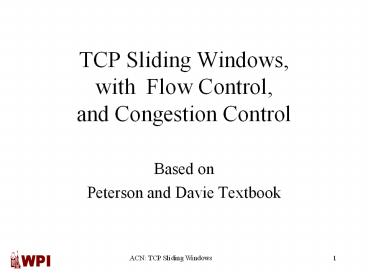TCP Sliding Windows, with Flow Control, and Congestion Control - PowerPoint PPT Presentation
Title:
TCP Sliding Windows, with Flow Control, and Congestion Control
Description:
TCP Sliding Windows, with Flow Control, and Congestion Control Based on Peterson and Davie Textbook – PowerPoint PPT presentation
Number of Views:35
Avg rating:3.0/5.0
Title: TCP Sliding Windows, with Flow Control, and Congestion Control
1
TCP Sliding Windows,with Flow Control,and
Congestion Control
- Based on
- Peterson and Davie Textbook
2
Sliding Windows
- Normally a data link layer concept
- Interest is understanding TCP mechanism at the
transport layer. - Each frame is assigned a sequence number - SeqNum
- The sender maintains three variables send window
size (SWS), last ACK received (LAR), and last
Frame sent (LFS)
3
Sender variables
- SWS the upper bound on the number outstanding
frames (not ACKed) the sender can transmit - LAR the sequence number of the last ACK
received - LFS the sequence number of the last frame sent
4
Sender Invariant
- LFS LAR lt SWS
ltSWS
LAR
LFS
5
Sender Window
- An arriving ACK ? LAR moves right 1
- ? sender can send one more frame
- Associate a timer with each frame sender
transmits - Sender retransmits the frame if the timer times
out - Sender buffer up to SWS frames
6
Receiver variables
- Receiver window size (RWS) the upper bound on
the number of out-of-order frames the receiver is
willing to accept - Largest acceptable frame (LAF) the sequence
number of the largest acceptable frame - Last frame received (LFR) the sequence number
of the last frame received
7
Receiver Invariant
- LAF LFR lt RWS
ltRWS
LFR
LAF
8
Receiver Window
- When a frame arrives with SeqNum
- If (SeqNum lt LFR or SeqNum gt LAF)
- the frame is discarded because it is outside
the window. - If (LFR lt SeqNum lt LAF)
- the frame is accepted.
9
Receiver ACK Decisions
- SeqNumToAck largest sequence number not yet
ACKed such that all frames lt SeqNumToAck have
been received. - Receiver ACKs receipt of SeqNumToAck
- set
- LFR SeqNumToAck
- LAF LFR RWS
10
TCP Sliding Windows
- switch from packet pointers to byte pointers
- Guarantees reliable delivery of data.
- Ensures data delivered in order.
- Enforces flow control between sender and
receiver. - The idea is the sender does not overrun the
receivers buffer
11
(No Transcript)
12
Receivers Advertised Window
- The big difference is the size of the sliding
window size at the receiver is not fixed. - The receiver advertises an adjustable window size
(AdvertisedWindow field in TCP header). - Sender is limited to having no more than
AdvertisedWindow bytes of unACKed data at any
time.
13
TCP Flow Control
- The discussion is similar to the previous sliding
window mechanism except we add the complexity of
sending and receiving application processes that
are filling and emptying their local buffers. - Also introduce complexity that buffers are of
finite size, but not worried about where the
buffers are stored. - MaxSendBuffer
- MaxRcvBuffer
14
TCP Flow Control
- Receiver throttles sender by advertising a window
size no larger than the amount it can buffer. - On TCP receiver side
- LastByteRcvd - LastByteRead lt MaxRcvBuffer
- to avoid buffer overflow!
15
TCP Flow Control
- TCP receiver advertises
- AdvertisedWindow MaxRcvBuffer -
- (LastByteRcvd -
LastByteRead) - i.e., the amount of free space available in the
receive buffer.
16
TCP Flow Control
- TCP sender must adhere to AdvertisedWindow from
the receiver such that - LastByteSent LastByteAcked lt AdvertisedWindow
- or use EffectiveWindow
- EffectiveWindow AdvertisedWindow
(LastByteSent LastByteAcked)
17
TCP Flow Control
- Sender Flow Control Rules
- EffectiveWindow gt 0 for sender to send more data
- LastByteWritten LastByteAcked lt MaxSendBuffer
- equality ? send buffer is full!!
- ? TCP sender must block sender application.
18
TCP Congestion Control
- CongestionWindow a variable held by source for
each connection. - TCP is modified such that the maximum number of
bytes of unacknowledged data allowed is the
minimum of CongestionWindow and AdvertisedWindow. - MaxWindow min (CongestionWindow ,
AdvertisedWindow )
19
TCP Congestion Control
- And finally, we have
- EffectiveWindow MaxWindow (LastByteSent
LastByteAcked) - The idea the source effective window can be no
faster than the slowest of the network (routers)
or the destination Host. - The TCP source receives implicit and/or explicit
indications of congestion by which to reduce
the size of CongestionWindow.































